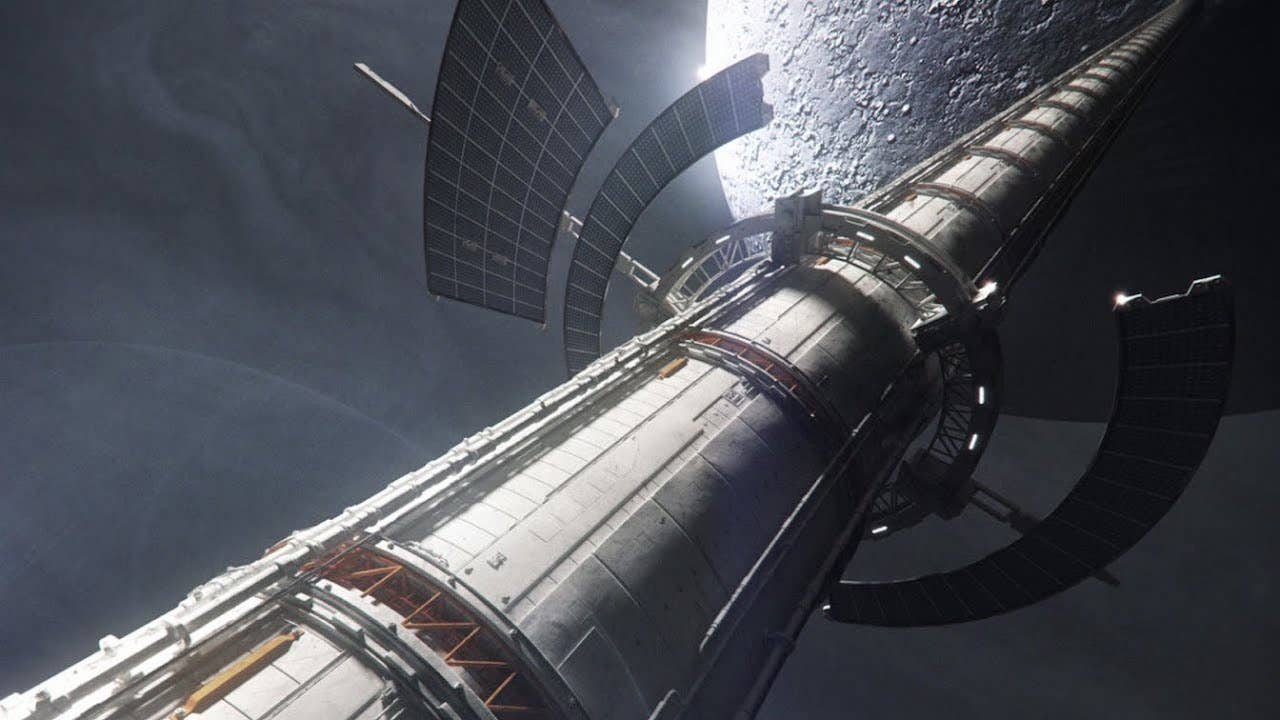Scientists believe a space elevator to the Moon is possible using today’s technology
One of the primary hurdles to our continued exploration and expansion across the solar system may be the overwhelming cost.

[May 25, 2023: Staff Writer, The Brighter Side of News]
One idea is to build a space elevator—a cable stretching from Earth to orbit that provides a way to climb into space. (CREDIT: Creative Commons)
One of the primary hurdles to our continued exploration and expansion across the solar system may be the overwhelming cost associated with overcoming Earth's gravitational pull. This is according to Zephyr Penoyre of the University of Cambridge, UK, and Emily Sandford of Columbia University, New York.
The issue at hand is fundamentally rooted in the working principles of rocket engines, which involve propelling mass in one direction to generate the necessary thrust in the opposite direction for spacecraft. This process requires significant amounts of propellant, which, although ultimately discarded, still needs to be accelerated in tandem with the spacecraft.
The cost of transporting a single kilogram into orbit is astronomically high, reaching tens of thousands of dollars. The expense only multiplies when considering missions to the moon and beyond, leading to a heightened interest in discovering more economical methods of reaching orbit.
One proposed solution involves constructing a space elevator. This concept involves a cable extending from the Earth's surface to the orbit, offering a route to ascend into space. The primary benefit of this system is the potential to harness solar energy for the climbing process, thus eliminating the need for onboard fuel.
However, this idea presents a significant challenge. The cable required for such an operation would have to possess exceptional strength. Carbon nanotubes are a possible material for this application, provided they can be developed to the necessary length. Unfortunately, currently available alternatives lack the required strength.
Related Stories
Penoyre and Sandford have revisited the concept of a space elevator, adding their own unique spin to it. They propose a version they've dubbed a "spaceline", which they argue could be constructed using materials that are currently commercially accessible.
Let's dive into some context first. The traditional idea of a space elevator involves a cable that's secured at the ground level and stretches beyond the geosynchronous orbit, a distance approximately 42,000 kilometers (26,098 miles) above the Earth.
A cable of this nature would carry substantial weight. To prevent it from descending, an equivalent mass in orbit would need to counterbalance it at the opposite end. Centrifugal forces would then bear the entire weight of the elevator.
For decades, an array of physicists, authors of science fiction, and dreamers have eagerly computed the magnitude of these forces. However, the resulting calculations have consistently led to disappointment. There is currently no identified material capable of withstanding these forces. This includes materials as strong as spider silk, Kevlar, or even the most resilient contemporary carbon fiber polymers.
Penoyre and Sandford are suggesting an alternative concept. Rather than having the cable anchored on Earth, they recommend that it be tethered to the moon and extended toward Earth.
The key distinction lies in the centrifugal forces. A traditional space elevator would rotate fully once per day, in sync with the Earth's rotation. However, a space elevator based on the moon would only orbit once every month, a significantly slower rate with proportionally reduced forces.
Furthermore, the arrangement of forces is different. A cable extending from the moon to Earth would traverse a zone in space where the gravitational pull of the Earth and moon neutralize each other.
This zone, referred to as a Lagrange point, would become a crucial component of such a moon-based space elevator. Below this point, closer to Earth, gravity would draw the cable toward the planet. Conversely, above this point, nearer to the moon, the cable would be pulled towards the lunar surface.
Penoyre and Sandford promptly demonstrate that if the cable extended from the moon to the surface of Earth, the resulting forces would be too overwhelming for current materials to withstand. However, the cable doesn't necessarily need to reach all the way to be effective.
The researchers' key finding highlights that current high-strength materials like carbon polymers, such as Zylon, have the capacity to sustain a cable extending from the moon to the geosynchronous orbit. They further propose that a prototype device, constructed from a cable roughly the diameter of a pencil lead, could be suspended from the moon at an expenditure amounting to billions of dollars.
It would reduce the fuel needed to reach the surface of the moon. (CREDIT: LIftPort)
This proposal is undoubtedly ambitious, yet not outside the realm of contemporary space missions. Penoyre and Sandford state, “By extending a line, anchored on the moon, to deep within Earth’s gravity well, we can construct a stable, traversable cable allowing free movement from the vicinity of Earth to the Moon’s surface,” say Penoyre and Sandford.
The potential for cost savings is considerable. The necessary fuel to reach the lunar surface would be cut to a mere third of its current demand, the researchers assert.
Simultaneously, this approach would unveil a new frontier in space exploration — the Lagrange point. This is noteworthy because both the gravitational pull and its gradient at this point are null, making it considerably safer for construction undertakings. In contrast, the gradient of gravity in low Earth orbit renders orbits substantially less stable.
The researchers, Penoyre and Sandford, illustrate this point using a simple analogy. “If you drop a tool from the International Space Station it will seem to rapidly accelerate away from you,” point out Penoyre and Sandford. “The Lagrange point has an almost negligible gradient in gravitational force; the dropped tool will stay close at hand for a much longer period.”
Additionally, this region is free from significant debris. Penoyre and Sandford indicate, “The Lagrange point has been mostly untouched by previous missions, and orbits passing through here are chaotic, greatly reducing the amount of meteoroids,” they say.
Penoyre and Sandford underline the substantial advantage of reaching the Lagrange point via the spaceline. They argue that the establishment of a base camp at the Lagrange point could significantly revolutionize the initial utilization of the spaceline, and more broadly, human space exploration. They envision such a base camp enabling the development and upkeep of advanced space-based experiments, potentially including telescopes, particle accelerators, gravitational wave detectors, vivariums, as well as power generation sites and launch stations for missions aimed at further solar system exploration.
This intriguing perspective rekindles interest in the concept of a space elevator. With more affordable access to the Lagrange point, the moon, and beyond, space exploration might have just become a much more attainable and cost-effective proposition.
Note: Materials provided above by The Brighter Side of News. Content may be edited for style and length.
Like these kind of feel good stories? Get the Brighter Side of News' newsletter.
Joseph Shavit
Head Science News Writer | Communicating Innovation & Discovery
Based in Los Angeles, Joseph Shavit is an accomplished science journalist, head science news writer and co-founder at The Brighter Side of News, where he translates cutting-edge discoveries into compelling stories for a broad audience. With a strong background spanning science, business, product management, media leadership, and entrepreneurship, Joseph brings a unique perspective to science communication. His expertise allows him to uncover the intersection of technological advancements and market potential, shedding light on how groundbreaking research evolves into transformative products and industries.



